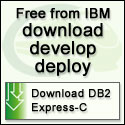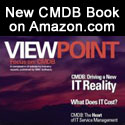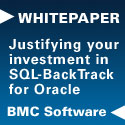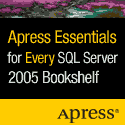Something “Old,” Something “New,” Neither True
By coincidence, the following two items were posted on Database Debunkings at about the same time. The first as one of our “Weekly Quotes”:
“Relational databases started to get to be a big deal in the 1970s, and they’re still a big deal today, which is a little peculiar, because they’re a 1960s technology.”
— Mark-Jason Dominus, Short guide to DBI
The second, in an exchange with a DAMA chapter on my proposal for a presentation:
“We had a board meeting last month after DAMA Day. Among other decisions, we assessed our members’ feedback and selected presentations for the fourth quarter of this year. Based on the input from our members, we decided to concentrate on business intelligence and emerging technology. I am sure you understand that our members’ needs are the priority and we would like to invite you to send us your proposals for next year’s program.”
Can you detect a connection?
As I argued — yet again! — in “Grinding Water,” the relational model is nothing but logic and mathematics — specifically, predicate logic and set theory — applied to data management. So the assertion that relational databases are old and, by inference, obsolete, is tantamount to claiming that logic and math are obsolete!
Even if we were to accept such an unsubstantiated claim — ridiculous on its face — it would certainly be incumbent on those taking this position to propose an alternative foundation for database management that is better than logic and mathematics. Alas, as I have kept demonstrating at Database Debunkings, relational critics make only fuzzy noises to that effect, and when cornered for specifics, disappear (see “On What Is a Data Model?” and “More On the ‘Associative Model of Data’”). Try, for example, to make sense of the following, if you can. This is what you get when you discard logic in general. Why would you use a technology promoted with such utter nonsense?
“I doubt that multi-value [databases] require replacement of predicate logic or set theory, just the obsolete physical constraints of attempting to force multi-dimensional real data into artificial columns-and-rows, thereby embedding in the physical layer the architecture of the logical (and as you implied, giving rise to the normalization/de-normalization debate in the first place, when should be purely a physical implementation issue). Codd didn’t reject the multi-value repeating group model; I contend that he simply had no perception of how to implement it ... I am certainly advocating a [data model] replacement, but for the two-dimensional physical data base architecture used in the fashionable, so-called relational databases.”
— S. VanArsdale, E-mail communication
Which brings me to the second item, the DAMA response. Without reliance on the sound foundation provided by logic, how should new data management technologies and products be assessed for consistency, completeness, and suitability to task? And how can we tell that they are really new?
Take, for example, XML. Here’s what you usually come across in the industry:
“... XML data is fundamentally different from relational data. XML data are extremely well suited to hierarchical storage ... In XML databases, an online tax return can be stored in its entirety. In a relational database, each line of the return would have to be a different table [of data in rows and columns]. Trying to ‘force fit’ an XML document into the rigid relational structure can waste storage space and lead to inefficiencies in queries and retrievals.”
— Database administrator
“Ironically, there is really no difference between a document and a database — In both cases, you have to abstract information and a certain amount of metadata that helps the system understand the meaning and uses of that extracted information.”
— Jan Stafford, XML's Challenge War On Words
In this case the need for an evaluation framework is more obvious than usual, because the two claims are actually contradictory! Here’s one example that is not that obvious. True, or false? And what difference does it make, if any?
“Summary: Pure OODB and RDB are fundamentally based on the same mathematical concept of relations. In RDB, it is relation/values. In OODB, the equivalent is class/instances.”
— www.dbforums.com
Confusion is the logical conclusion of lack of fundamental knowledge and clear thinking. Despite having been debunked over and over, the fallacy of equating object classes with relations persists. In fact, object classes are data types and the main flaw of object orientation in data management is precisely the absence of a construct equivalent to relations, in which instances of the object classes — the objects — can be recorded (see “Practical Issues in Database Management”).
The point is that lack of proper education and foundation knowledge leads practitioners to judge a sound foundation developed over thousands of years as “old” and, therefore, “obsolete.” And, these individuals focus on purportedly “new technologies” that are nothing of the kind, and in fact are not just old, but truly obsolete, as they have already been tried and discarded (see my comments on XML in my last month’s column).
As I state in my seminars and paper #4 in Database Foundation Series, Un-Muddling Modeling: It Depends on What the Meaning of Means Means:
Any data management technology claimed to be a better substitute for the relational data model:
- Must have a data model that
- Is complete
- data types
- structure
- integrity
- manipulation
- Has a formal foundation as precise and sound as
- predicate logic
- set theory
- normalization theory
- Is as general
- Is simpler
Otherwise put, practitioners should educate themselves and assess any proposed technology or product on its sound foundation which, in data management, is logic and mathematics. Dismissing the foundation as “old” — due to lack of education — prevents them from making proper evaluations and fools them into accepting obsolete technologies as new — that’s upside down and backwards. It is neither intelligent, nor the way to evaluate “business intelligence.”
No wonder that, under the current circumstances, technology is regressing.
--
Fabian Pascal has a national and international reputation as an independent technology analyst, consultant, author and lecturer specializing in data management. He was affiliated with Codd & Date and for 20 years held various analytical and management positions in the private and public sectors, has taught and lectured at the business and academic levels, and advised vendor and user organizations on data management technology, strategy and implementation. Clients include IBM, Census Bureau, CIA, Apple, Borland, Cognos, UCSF, and IRS. He is founder, editor and publisher of Database Debunkings, a web site dedicated to dispelling persistent fallacies, flaws, myths and misconceptions prevalent in the IT industry. Together with Chris Date he has recently launched the Database Foundation Series of papers. Author of three books, he has published extensively in most trade publications, including DM Review, Database Programming and Design, DBMS, Byte, Infoworld and Computerworld. He is author of the contrarian columns Against the Grain, Setting Matters Straight, and for The Journal of Conceptual Modeling. His third book, PRACTICAL ISSUES IN DATABASE MANAGEMENT serves as text for his seminars.
Special Offer: Author Fabian Pascal is offering DBAzine.com readers copies of his papers and abstracts at a discount. To receive your discount, just let the editor know you're a DBAzine reader!
Contributors : Fabian Pascal
Last modified 2005-04-12 06:21 AM




